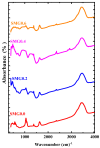Exploring the FTIR, Optical and Nuclear Radiation Shielding Properties of Samarium-Borate Glass: A Characterization through Experimental and Simulation Methods
- PMID: 34209698
- PMCID: PMC8306404
- DOI: 10.3390/nano11071713
Exploring the FTIR, Optical and Nuclear Radiation Shielding Properties of Samarium-Borate Glass: A Characterization through Experimental and Simulation Methods
Abstract
(Tl2O3)30-(Li2O)10-(B2O3)(60-y)-(Sm2O3)y glass system with various Sm2O3 additives (y = 0, 0.2, 0.4, 0.6) was studied in detail. The vibrational modes of the (Tl2O3)30-(Li2O)10-(B2O3)(60-y) network were active at three composition-related IR spectral peaks that differed from those mixed with Samarium (III) oxide at high wavenumber ranges. These glass samples show that their permeability increased with the Samarium (III) oxide content increase. Additionally, the electronic transition between localized states was observed in the samples. The MAC, HVL, and Zeff values for radiation shielding parameters were calculated in the energy range of 0.015-15 MeV using the FLUKA algorithm. In addition, EBF, EABF, and ΣR values were also determined for the prepared glasses. These values indicated that the parameters for shielding (MAC, HVL, Zeff, EBF, EABF, and ΣR) are dependent upon the Samarium (III) oxide content. Furthermore, the addition of Samarium (III) oxide to the examined glass samples greatly reinforced their shielding capacity against gamma photon. The findings of the current study were compared to analyses of the XCOM software, some concretes, and lead. In the experiment, it was found that the SMG0.6 glass sample was the strongest shield.
Keywords: MC simulation; Sm-B2O3 glass; optical property; radiation attenuation property.
Conflict of interest statement
The authors declare no conflict of interest.
Figures

















References
-
- Yim M.-S., Ocken H. Radiation dose management in nuclear power plants. Prog. Nucl. Energy. 2001;39:31–51. doi: 10.1016/S0149-1970(01)00002-6. - DOI
-
- Al-Buriahi M.S., El-Agawany F.I., Sriwunkum C., Akyıldırım H., Arslan H., Tonguc B.T., El-Mallawany R., Rammah Y.S. Influence of Bi2O3/PbO on nuclear shielding characteristics of lead-zinc-tellurite glasses. Phys. B Condens. Matter. 2020;581:411946. doi: 10.1016/j.physb.2019.411946. - DOI
-
- Zakaly H.M.H., Saudi H.A., Issa S.A.M., Rashad M., Elazaka A.I., Tekin H.O., Saddeek Y.B. Alteration of optical, structural, mechanical durability and nuclear radiation attenuation properties of barium borosilicate glasses through BaO reinforcement: Experimental and numerical analyses. Ceram. Int. 2021;47:5587–5596. doi: 10.1016/j.ceramint.2020.10.143. - DOI
-
- Zakaly H.M.H., Rashad M., Tekin H.O., Saudi H.A., Issa S.A.M., Henaish A.M.A. Synthesis, optical, structural and physical properties of newly developed dolomite reinforced borate glasses for nuclear radiation shielding utilizations: An experimental and simulation study. Opt. Mater. 2021;114:110942. doi: 10.1016/j.optmat.2021.110942. - DOI
-
- Alalawi A. Experimental and Monte Carlo investigations on the optical properties and nuclear shielding capability of Bi2O3–Na2O-B2O3–Cu2O glasses. J. Non. Cryst. Solids. 2020;548:120321. doi: 10.1016/j.jnoncrysol.2020.120321. - DOI
LinkOut - more resources
Full Text Sources

